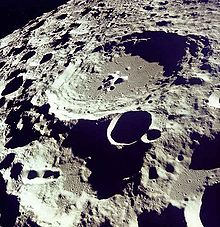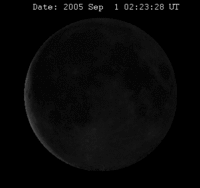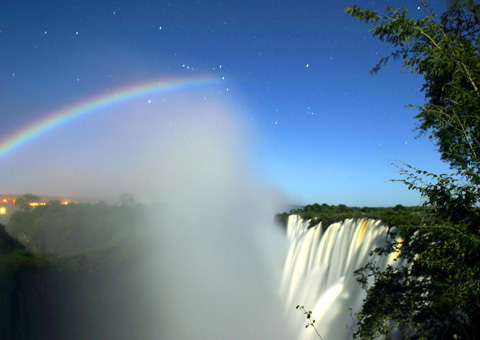Entertaining Astronomy - Moon Facts
 For a start - a few numbers:
For a start - a few numbers:- The volume of the Moon is 21.99 · 10 9 km 3 or only 2% of the volume of the Earth, and this despite the fact that:
- The diameter of the moon 3476.0 km = 0.2725 eq. Earth's diameter (about a quarter of the earth).
- The surface area of the moon is 37.96 · 10 6 km 2 = 0.074 of the surface area of the Earth (approximately 1/14 of the Earth’s).
- The average distance from the moon to the earth is 384,400 km.
- The orbital speed of the moon is 3,679.2 km / h = 1.022 km / s.
- The apparent angular diameter of the moon at an average distance from the Earth 31'05 ", 16.
- The mass of the moon is 7.35 · 10 25 g = 0.0123 of the mass of the earth (1/81 of the earth’s).
- The acceleration of free fall on the surface of the moon is 1.63 m / s 2 = 16.5% of the earth's.
- The second cosmic velocity is 2.38 km / s (11.2 km / s near the Earth).
Interesting
Everyone knows that the Moon is always facing one side of the Earth, but few know that, thanks to libration, about 59% of the lunar surface can be observed in total. This phenomenon was discovered by Galileo Galilei in 1635, when he was convicted by the Inquisition.
About this and many other things we read under the cut.

Lunar librations.
The rotation of the Earth-Moon system does not occur around the center of the Earth, but around the center of mass of the Earth-Moon system, which is located 1,700 km below the Earth's surface.
')
The moon has a high temperature difference on the surface. Since there is practically no atmosphere on the Earth’s satellite, during the daytime the Moon heats up to +120 º, and at night or in the shade the Moon cools to -160 º.
Lunar day and night last for 14.8 Earth days.
The sky of the moon is always black, even during the day, since the rays of the sun are not scattered in it.
The disk of the Earth looks from the Moon 3,67 times larger than the Moon from the Earth and hangs almost motionless.
The sun attracts the moon 2.2 times stronger than the earth.
The full moon reflects only 7% of the sunlight falling on it.
Illumination by the reflected light of the Earth is about 50 times stronger than illumination by moonlight on Earth.
Light fired from Earth reaches the moon in 1.28 seconds

Due to tidal synchronization, the Moon is always facing the Earth on one side, and its orbit is a slowly unwinding spiral - the Moon gradually moves away from the Earth at a speed of about 38 mm / year.
After millions of years, this tiny change, as well as an increase in Earth day of 23 microseconds per year, will lead to significant changes. For example, in the Devonian period (about 410 million years ago) there were 400 days a year, and a day lasted 21.8 hours.
The maximum amplitude of the tidal wave on Earth is observed in the Bay of Fundy in Canada and is 18 meters.
The tidal force of the Sun is on average 2.17 times smaller than the lunar one.
The moon is the eighteenth card (lariat) of the tarot .
During a lunar eclipse (even a full one), the moon does not disappear completely, but becomes dark red. This is due to the fact that the earth's atmosphere best passes through the shades of red through itself, which is clearly visible during sunset or dawn. It is this diffuse "sunset" color that illuminates the moon during an eclipse.

The illusion of the moon (“ lunar illusion ”) is an optical illusion in which the perceived size of the moon is about one and a half times larger when it is low above the horizon compared to how it is perceived when it is high in the sky (at the zenith), although in both cases, the projections on the retina are equal.
When a person looks at the moon, the rays of moonlight form an image about 0.15 mm in size on his retina.
From Earth, the apparent size of the moon is very close to the apparent size of the sun. The angular dimensions (or solid angle) of these two celestial bodies are similar insofar as the diameter of the Sun and the lunar one is 400 times larger, it is 400 times farther from the Earth.
The lunar rainbow (also known as the night rainbow) is a rainbow generated by the moon more than by the sun. Moonlight rainbow is relatively paler than usual. This is explained by the fact that the moon produces (reflects from the sun) less light than the sun. The lunar rainbow is always on the opposite side of the moon from the sky.

The most common theory of the origin of the moon, the Theory of Giant Collision, argues that the Moon was formed as a result of the collision of the protoplanet Thea (about the size of Mars) with the early Earth. This hypothesis, among other things, explains the reasons for the similarities and differences in the composition of the lunar soil and the earth.
Prepared based on Wikipedia and other scientific and educational sites about the Moon in particular, and astronomy in general.
Source: https://habr.com/ru/post/96849/
All Articles